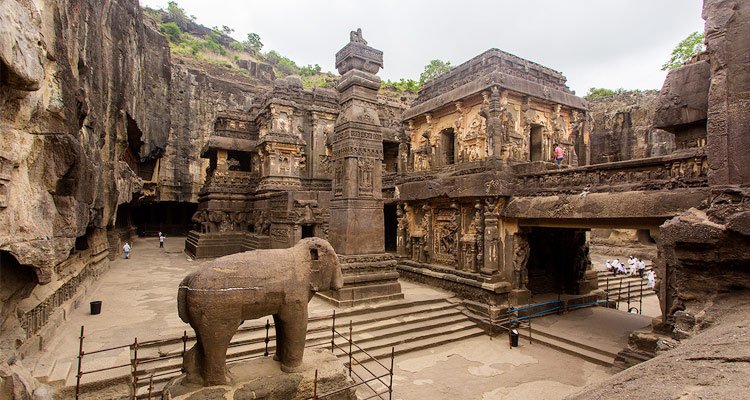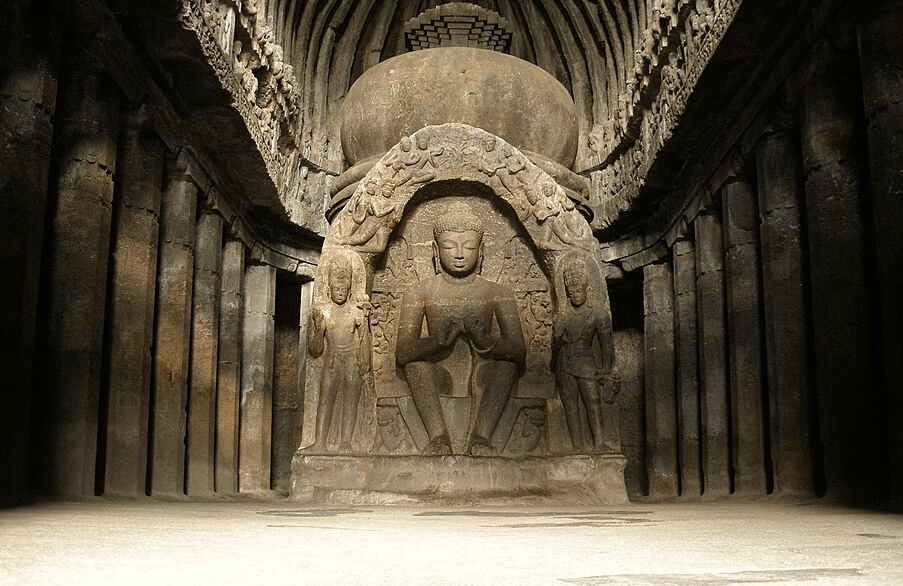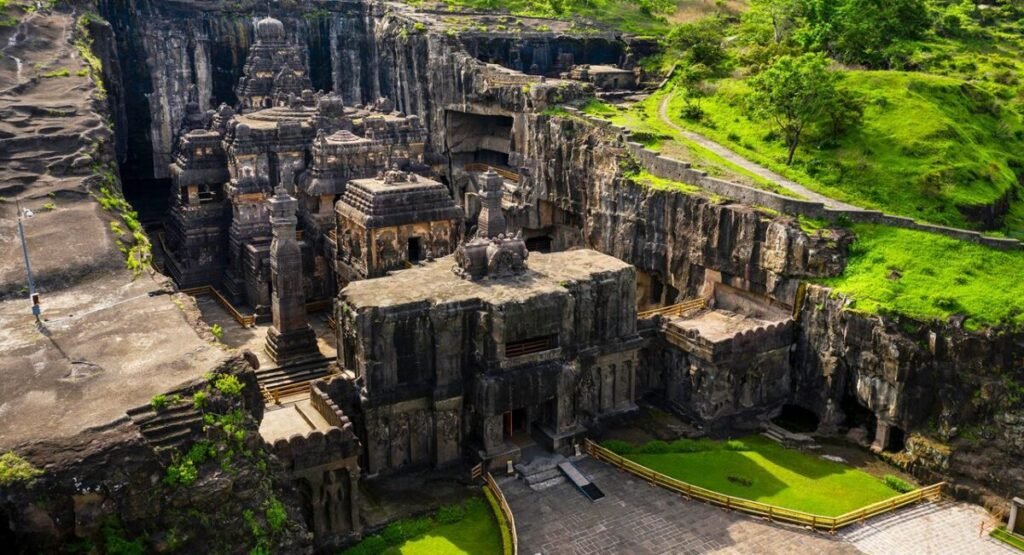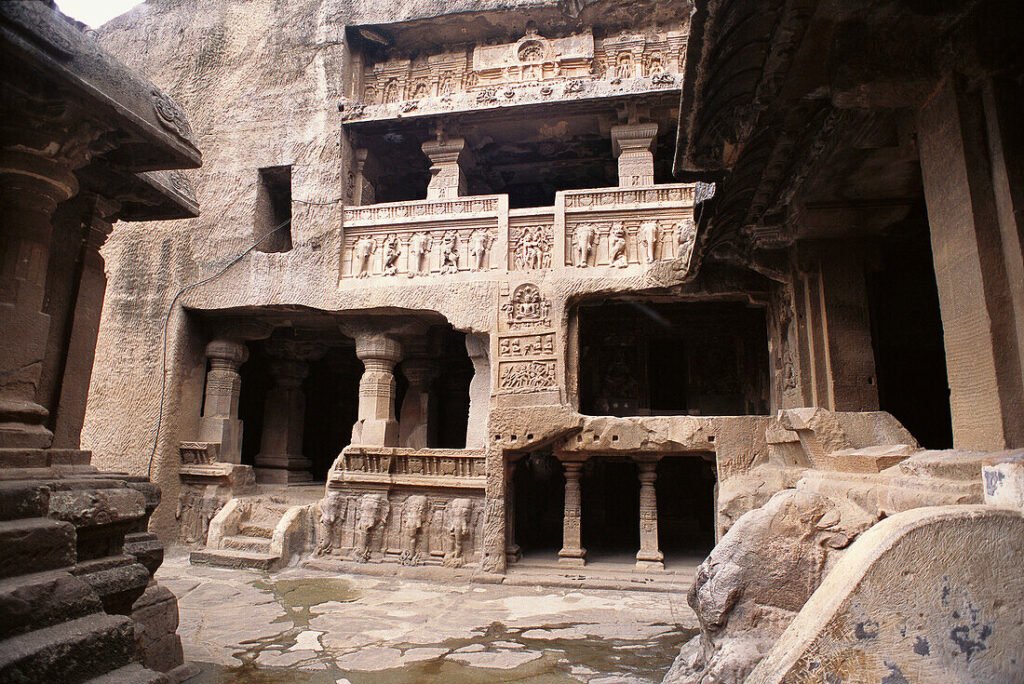Explore Ellora Caves — Where Hindu, Buddhist, and Jain Heritage Unite
Discover the Ellora Caves, a UNESCO World Heritage Site near Aurangabad, Maharashtra, and step into a world of ancient art, spirituality, and history. Moreover, this breathtaking site features 34 magnificent rock-cut caves representing Buddhism, Hinduism, and Jainism. In addition, each cave reflects extraordinary craftsmanship and the cultural harmony of ancient India. Furthermore, Ellora is a perfect destination for history enthusiasts, culture lovers, and spiritual seekers alike. Thus, plan your journey with Dhyanam India Tours to explore these timeless wonders in comfort and style.
Location & How to Reach Ellora Caves
The Ellora Caves are located about 30 km from Aurangabad. Additionally, the nearest railway station and airport are in Aurangabad, providing convenient connections from major cities across India. Furthermore, we offer guided tours, which ensure you make the most of your visit while learning fascinating stories behind every sculpture and carving.
History of Ellora Caves

The Ellora Caves are among the most magnificent examples of rock-cut architecture in India. Furthermore, these caves were built between the 5th and 10th centuries CE during the rule of the Rashtrakuta dynasty. In addition, earlier dynasties like the Chalukyas and Kalachuris also contributed to their construction, adding to their historical and artistic significance.
Ellora is unique because it showcases the coexistence of three major religions — Buddhism, Hinduism, and Jainism — all carved into the same basalt cliffs of the Ellora Caves, also known as the Charanandri Hills. Moreover, this represents not only India’s artistic excellence but also the spirit of religious tolerance and unity that prevailed during ancient times. In addition, visitors can witness how these diverse traditions harmoniously coexist in one architectural marvel.
The Ellora Caves were never truly “lost” to history, unlike the Ajanta Caves, which were hidden for centuries under dense forest. As a result, Ellora remained a well-known pilgrimage site throughout the medieval period. Furthermore, its continuous use helped preserve many of the caves, sculptures, and inscriptions for future generations to admire.
However, it gained international recognition in the early 19th century, when British officers and archaeologists began to study and document its sculptures and inscriptions in detail. Their reports brought Ellora to the world’s attention as one of the greatest rock-cut temple complexes ever created.
Explore the Three Religious Traditions
Buddhist Caves (Caves 1–12)
The earliest caves, dating from the 5th–7th centuries, are Buddhist monasteries and prayer halls (viharas and chaityas). These caves feature beautiful Buddha statues, Bodhisattvas, and murals depicting ancient Buddhist teachings. Highlights include Cave 10, also called the Vishvakarma Cave, renowned for its large Buddha statue and intricate artwork.
– Vishvakarma Cave (Cave 10) – The Carpenter’s Cave, Ellora

The Vishvakarma Cave, also known as the Carpenter’s Cave, is one of the most famous Buddhist caves in the Ellora Caves complex in Maharashtra. It is Cave No. 10 and dates back to the 7th century CE. The cave gets its name from Vishvakarma, the divine architect in Hindu mythology, as it showcases exceptional craftsmanship carved entirely out of rock.
Architectural Highlights
- Type: Chaitya Hall (prayer hall)
- Structure: The cave has a large central stupa with a beautifully sculpted seated Buddha in front, representing him preaching.
- Ceiling Design: The roof is carved to look like wooden beams, giving it the nickname “Carpenter’s Cave.”
- Pillars & Arches: The cave features intricately carved pillars and horseshoe-shaped arches, which add to its grandeur.
- Façade: The entrance includes detailed carvings of Buddha, Bodhisattvas, and celestial beings, welcoming visitors into a serene atmosphere.
Spiritual & Artistic Significance
- The Buddha seated on the stupa symbolizes enlightenment and peace.
- The cave served as a prayer and meditation hall for Buddhist monks.
- It is a masterpiece of rock-cut architecture, representing the final stage of Buddhist cave art in India before the decline of this tradition.
Hindu Caves (Caves 13–29)
The Hindu caves, built between the 7th–9th centuries, showcase elaborate carvings of gods, goddesses, and mythological stories. The star attraction is the Kailasa Temple (Cave 16)—a monolithic masterpiece carved from a single rock. Its grand courtyards, towering pillars, and detailed sculptures make it one of the most impressive rock-cut temples in the world.
– Kailash Mandir (Cave 16)

Cave 16, famously known as Kailash Mandir, is a crown jewel of Indian rock-cut architecture. Carved entirely from a single rock during the 8th century under the Rashtrakuta dynasty, it demonstrates the extraordinary skill of ancient artisans.
Architectural Brilliance
Dedicated to Lord Shiva, Kailash Mandir replicates Mount Kailash, Shiva’s mythical abode. Inside, a central shrine houses the Shiva Linga, and intricate carvings of deities and epic scenes adorn the walls. Moreover, the elaborate pillars, sculptures, and grand courtyard reflect the design of a sprawling temple town. Standing over 100 feet high, 200 feet long, and 160 feet wide, the temple is the largest monolithic rock excavation in the world. Every sculpture tells a story of devotion, mythology, and artistry.
Significance
Kailash Mandir is not just an architectural marvel; it offers a spiritual journey. It represents the devotion of ancient artisans, symbolizes Mount Kailash, and influenced later rock-cut temples across India.
Jain Caves (Caves 30–34)

The Jain caves, dating from the 9th–10th centuries, are smaller yet exquisitely detailed. They are dedicated to various Tirthankaras and include fine sculptures and serene spaces, with Cave 32 (Indra Sabha) standing out for its elegant carvings and ornamental pillars.
Architectural Marvels of Ellora
The Ellora Caves are a true testament to ancient Indian craftsmanship. Moreover, carved from top to bottom, each cave reflects exceptional precision, artistry, and vision. In particular, the Kailasa Temple, carved entirely from a single rock, is awe-inspiring, with multi-level courtyards, detailed sculptures, and intricate designs. As a result, it attracts travelers, historians, and art enthusiasts from around the world.
Best Time to Visit
The best months to explore Ellora are October to March, when the weather is pleasant and ideal for sightseeing. During this period, you can enjoy your visit comfortably while fully appreciating the grandeur of the caves.
Capture Timeless Memories
From the majestic Kailasa Temple to the serene Buddhist and Jain caves, Ellora offers endless photography opportunities. Capture not just the art, but also the spiritual ambiance that has inspired travelers for centuries.
A Spiritual Journey
Visiting Ellora is more than sightseeing—it’s a spiritual experience. Walk through the caves, feel the devotion etched in every sculpture, and connect with India’s ancient cultural heritage.
Plan Your Ellora Caves Tour With Us
Make your visit stress-free and enriching with our customized tours. From guided explanations of each cave to comfortable travel arrangements, we ensure that your Ellora journey is unforgettable.
Plan your Ellora Caves tour today and explore the marvels of ancient India with us!
